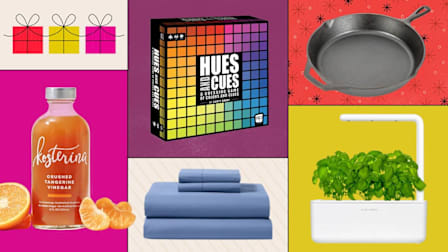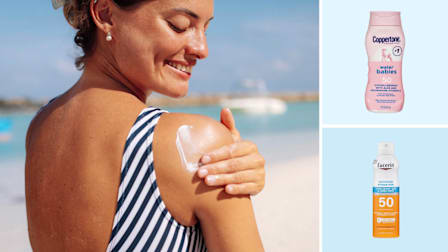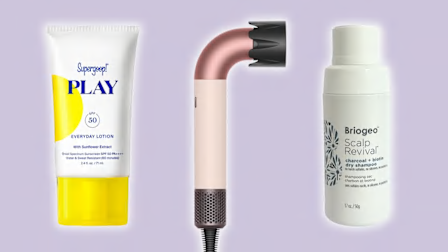Generation Z Wants a Tan
TikTok has become a source of misinformation about tanning and sunscreen—and it’s putting Gen Z at risk
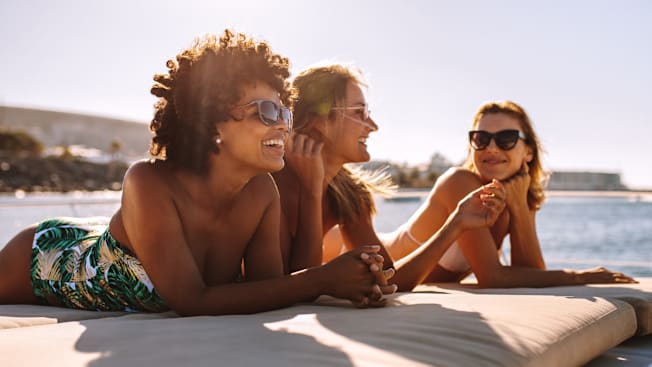
“Mom, I heard if you sit outside wearing olive oil you’ll tan faster.”
My 13-year-old daughter Kiera says this one random June day and I wonder if I’m living in a sci-fi film in which my child has been reincarnated as Coco Chanel (who, legend has it, started the sun tan craze in 1923 when she accidentally fell asleep on her yacht in the French Riviera and burned to a fetching crisp).
Then Kiera plunges the dagger into my heart: “Mom, can I get a tan?”
Gasp. This is the same Sephora-obsessed teen who has a skincare fridge in her room filled with overpriced serums she doesn’t need and a Gua Sha rose quartz facial massager for the lymphatic drainage she doesn’t need. She has watched me slather on SPF 50 every day for the last 13 years of her life. We’ve never had a trip to the beach or pool that didn’t involve her succumbing to several re-applications of sunscreen.
Her generation is watching, in real-time, as their baby boomer grandparents deal with the repercussions of too much time spent unprotected in the sun in their youth. Cases of Merkel cell carcinoma (a rare type of skin cancer that is often fatal) are rising six times faster in the U.S. than most other cancers and aging baby boomers are anticipated to propel these cases. And the incidence of melanoma rose 320 percent between 1975 and 2018.
Outside my home, which is located near a beach town on the outskirts of New York City, proof of tanning exploits abound. While in the car one afternoon, Kiera and I pass three teen girls lying out with their heads propped on the curb outside of a GameStop. “Are they asleep?” I ask. Kiera laughs. “No, mom, they’re tanning.” They’re tanning?!
If You're Going to the Beach, CR Has You Covered
See our reviews of beach chairs, beach tents, and beach canopies.

A tan is your body’s way of producing melanin to protect itself from radiation, from ultraviolet radiation. So it’s basically your body’s way of giving you an SOS to say, ‘Whoa, I am in protective mode.’
Dermatologist at Dermatology Physicians of Connecticut
Gen Z Sunscreen and Tanning Myths
According to a 2024 national survey by Orlando Health Cancer Institute, about one in seven (14 percent) adults under the age of 35 believe that daily sunscreen use is more harmful to the skin than direct sun exposure, and 23 percent believe drinking water and being hydrated can prevent sunburn. There’s a bit of debate over why some are avoiding sunscreen and believing alternative facts about sun exposure, with some writing on Reddit that they believe that it prevents vitamin D absorption and that some wellness influencers are pushing tips like “eat more foods with antioxidants” in place of wearing sunscreen.
Gohara says there is no science behind that thinking. “What we do know is that one blistering sunburn or five regular sunburns, double your risk of melanoma, which is a deadly skin cancer over a lifetime,” Gohara says. “And most people have had one sunburn or one blistering sunburn or five regular sunburns. So anyone picking themself up to not wear sunscreen is essentially really putting themself at a very high risk for skin cancer. If they feel that they want a sunscreen with less chemicals in it, they can choose one with titanium or zinc, which are naturally occurring minerals.”
That isn’t the only alarming statistic about Gen Z and tanning. In 2023, the American Academy of Dermatology (AAD) surveyed more than 1,000 adults in the U.S. and found that 71 percent of Gen Z adults (between the ages of 18 and 25) are unfamiliar with the risks of sunburn, with 59 percent of them believing tanning is “healthy” and that a “base tan” can prevent sunburn.
“Getting a base tan, that’s a complete fallacy,” Gohara says, adding that once the sun has tanned your skin at all, the damage is already done.
Some health experts are staging a social media counteroffensive by creating content that is pro-sunscreen and anti-tanning, but Henry says whenever she posts a video about the importance of wearing sunscreen, it is received with anger by some commenters. “I think they’re getting a lot of misinformation, and that’s why it’s really important that physicians are at the table and participating in social media and all of these conversations [so] that our voices can be louder,” Henry says. “I get attacked on social media for telling people to wear sunscreen all of the time. So it’s a tough battle.”
I sat Kiera down for a brief interview to find out how much of these messages she has absorbed. She downloaded TikTok for the first time six months ago.
Mom: Why do you want a tan?
Kiera: It looks good. It adds to your looks.
Mom: How dangerous do you think it is to tan?
Kiera: You wear sunscreen while you tan. I thought you can’t get cancer if you wear sunscreen while tanning.
Mom: Do your friends tan?
Kiera: Yes. They use tanning oil.
Mom: Where do you get tanning tips?
Kiera: TikTok. I know my sources aren’t reliable.
Mom: At what age do you think skin cancer is detected?
Kiera: In your 20s.
The Truth About Youth and Skin Cancer
Kiera was spot-on about one thing: Even though the risks increase with age, melanoma is the third most diagnosed cancer among individuals aged 25 to 39 in the U.S., and for individuals ages 15 to 29, it’s the ninth most common cancer. Gohara says that the first sign of aging and sun damage she frequently sees in people as early as their teens are freckles on their skin. While it could be youth and a lack of perspective talking, the AAD’s survey found that 20 percent of Gen Z adults said getting a tan was more important to them than preventing skin cancer.
The AAD recommends that everyone use a broad-spectrum sunscreen with SPF 30 or higher every day, even when it’s cloudy outside. Apply it 15 minutes before going outside and re-apply it every two hours (or right after exposure to water). The AAD also advises avoiding tanning beds, wearing sun-protective clothing—for more protection, wear items with an ultraviolet protection factor (UPF) on the label—and seeking shade between 10 a.m. and 2 p.m., when the sun’s rays are strongest. Consumer Reports has tested dozens of mineral and chemical sunscreens. You can see our top picks here. It’s critical that you find a sunscreen you’ll actually use.
Is Gen Z Really Different?
Gen Z has something that previous generations didn’t have at an early age: TikTok and social media platforms that promote education (including valuable scary stories from skin cancer survivors) and lies about tanning and sunscreen. But is Gen Z so different from their parents, aunts, uncles, and grandparents in terms of their attitude toward tanning?
Henry says she thinks it is a bigger problem now, and that the root problem is a lack of trust in medical experts and their advice when it comes to health, including sunscreens and sun exposure. “They’re the digital native generation who’ve been flooded with information but not education,” Henry says of Gen Z. “They’re the generation who grew up hearing things like ‘Fake news, don’t trust this. Vet your source.’ And they’re confused. We’ve taught them not to trust what they read, but we’ve not taught them how to figure out what to trust, right?”
In an environment where trust has been eroded, it’s difficult for Gen Z to figure out the importance of expertise. And this makes it even easier for a charismatic influencer with no medical background or knowledge of science to swoop in, throw around the words “toxic” and “chemicals,” and create panic.
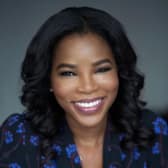
They’re the generation who grew up hearing things like ‘Fake news, don’t trust this. Vet your source.’ And they’re confused. We’ve taught them not to trust what they read, but we’ve not taught them how to figure out what to trust, right?
Dermatologist at Skin & Aesthetic Surgery of Manhattan
But Gohara isn’t so sure that tanning is a bigger problem with Gen Z than previous generations. “I think that there’s always a cohort when it comes to tanning who just is like that, ‘Go big or go home’ mentality,” Gohara says. “I’ve seen it consistently, but I’m a dermatologist, so it’s selection bias because that’s who comes into my office with burns and skin cancers, et cetera.”
Back in the day, Coco Chanel’s yacht tan turned the Caucasian pale beauty standard that was popular in the early 20th century on its head. In the 1950s and ‘60s, baby boomers had surf movies like Gidget that created a tan-crazed phenomenon. In the ‘90s, Gen-X had Pamela Anderson and her bronzed Baywatch cohort. And in 2024, Gen Z has TikTok, wellness scares over chemicals in sunscreen, and apps that let you know when the UV index is 13 and it’s an ideal time to tan (please don’t do that).
I hope when Kiera’s ready to rebel she’ll dye her hair pink and leave our olive oil in the pantry where it belongs. But I also know my best chance of that happening is having conversations with her and dispelling social media myths.





























